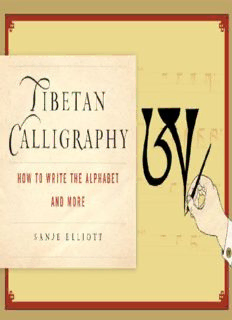
Tibetan Calligraphy How to Write the Alphabet and More PDF
Preview Tibetan Calligraphy How to Write the Alphabet and More
TIBETAN CALLIGRAPHY This book is dedicated to bodhichitta, the wish that each and every being may achieve enlightenment, becoming free from the causes of suffering and suffused with the causes of true happiness. TABLE OF CONTENTS Foreword by Sarah Harding Introduction 1. Getting Started 2. The Fundamental Pen Strokes 3. The Alphabet 4. Vowel Markers 5. Stacked Letters 6. The Six Reversed Letters 7. Punctuation 8. Numerals 9. Seed Syllables 10. Mantras 11. Prayers Afterword Additional Resources Acknowledgments About the Author FOREWORD T IBET IN THE SEVENTH CENTURY was at the height of its political, economic, and military might, with influence throughout much of Asia and the subcontinent. The great King Songtsen Gampo (617–90) had married two Buddhist princesses (considered to be emanations of Green and White Tara), and under their influence Buddhism was flourishing as well. Soon, the king recognized the need of a written script for both his statecraft and to support the spread of Buddhism. He therefore decided to send his prime minister, Thönmi Sambhota, to study in India at the great Buddhist university of Nalanda for some years. Upon his return, Sambhota worked on developing a system of writing that would accommodate the needs of Tibetans and of Buddhism. So it is Sambhota that is credited with the creation of the alphabet and writing system that is still in use. Anam Thubten Rinpoche writes: Skill in calligraphy was highly regarded as an important subject of study in society. It not only served the holy scriptures, but helped the individual in his or her daily life. The position of Calligrapher elevated one to aristocratic status, and the lifestyle enjoyed as such was far beyond that of the common person. In public schools calligraphy became one of the main subjects of study. At Mindroling monastery [for example], it took six years to graduate in calligraphy. Tibetan calligraphy continued to evolve over time to include many styles and characters, and its practice is still considered to be a component of one of the ten arts and sciences that relate to individual spiritual practice. The practice ranges from the foundation of perfect penmanship, to the most elaborate and creative flourishes, to the simple strokes of a mind at ease. Above all, calligraphy holds and transmits the word of the Buddha in all its many manifestations, and thus embodies a worthy object of refuge: the Jewel of the Dharma. Now for us it may seem that the art of Tibetan calligraphy has bifurcated into the two worlds of unicode font geeks and tattoo parlors. But let us not lose sight so easily of this important practice. The written word contains much magic beyond being a simple, or complicated, conveyance of information. Ancient spiritual traditions have always recognized the power of the word, both as utterance and as symbol. The great Buddhist languages, such as Sanskrit, Pali, and Tibetan, manifest this power both explicitly and implicitly. In studying the Buddhist teachings, one has many ways of relating to the media of its transmission. Not the least of these methods is simply beautiful writing. There is no one more capable of conveying this than Sanje Elliott. A great artist in his own right, he has studied and taught the art of Tibetan thangka painting for many years. He has mastered the traditional, highly refined styles of Tibet and at the same time developed his own creative interpretations. Now in this book of traditional calligraphy, we too can learn the necessary foundation of Tibetan writing, perhaps in order to explore later our own creative relationship with the language. I am grateful for this needed addition to the field and will use it immediately in teaching Tibetan. —Sarah Harding Thönmi Sambhota, creator of the uchen alphabet. SARAH HARDING has been the director of the Tibetan Language Correspondence Course since 1987 and an associate professor at Naropa University since 1992. Some of her books include Creation and Completion; Machik’s Complete Explanation; The Life and Revelations of Pema Lingpa; and Niguma: Lady of Illusion.
Description: